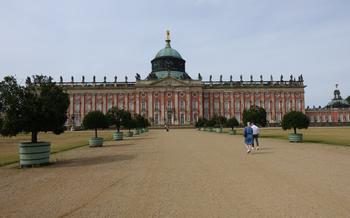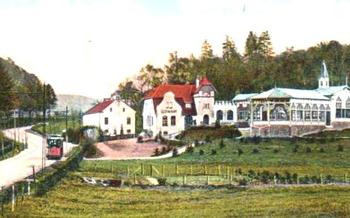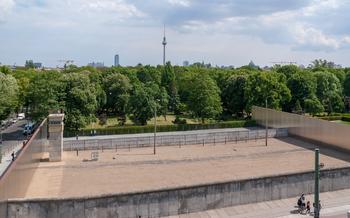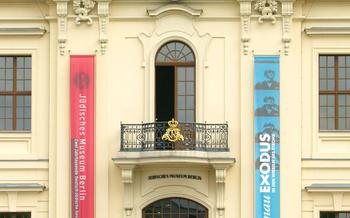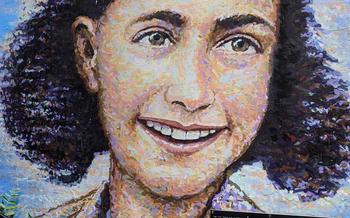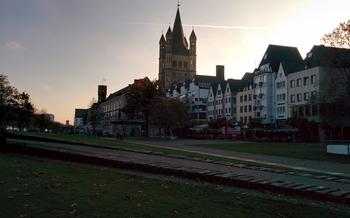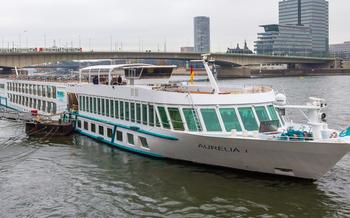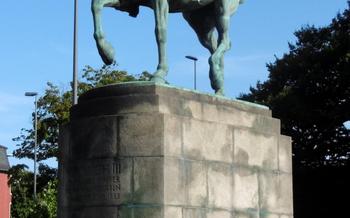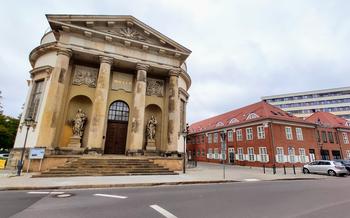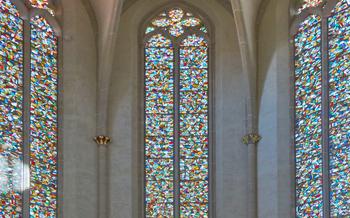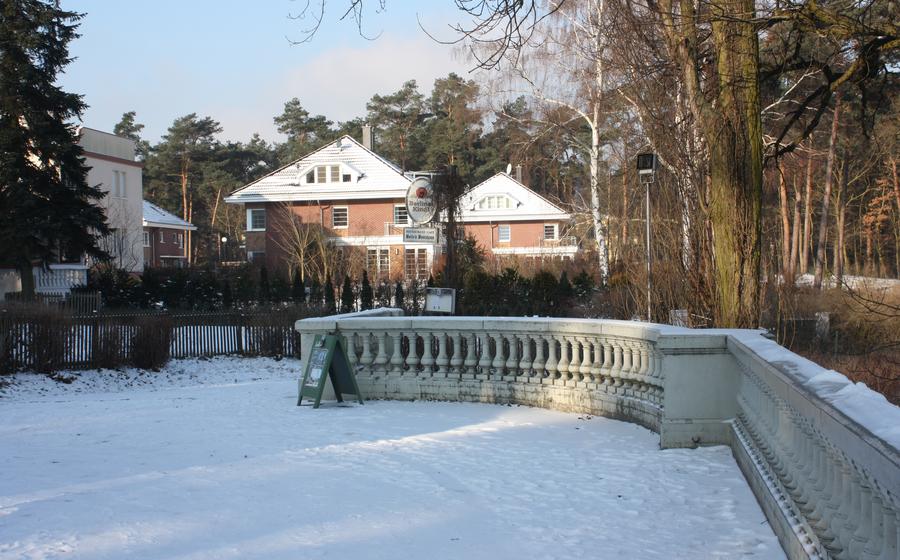
The Wannsee House
- Location and Accessibility
- Visiting Information
- Educational Programs and Workshops
- The Gardens and Memorial Site
- Audio Guides and Multimedia Displays
- Research Center and Archives
- Temporary Exhibitions and Special Events
- Educational Resources for Teachers
- Accessibility for Visitors with Disabilities
- Gift Shop and Bookstore
- Café and Restaurant
- Sustainability and Environmental Initiatives
- Insider Tip: Plan Your Visit in Advance
Location and Accessibility
The Wannsee House is conveniently located in the Wannsee district of Berlin, Germany. Its complete address is Am Großen Wannsee 56-58, 14109 Berlin. To reach the house by public transportation, visitors can take the S-Bahn (suburban train) to the Wannsee station and then transfer to bus 114 or 218, which will take them directly to the house. Alternatively, visitors can take bus 116, which stops right in front of the house. For those arriving by car, there is limited street parking available in the surrounding area. It is advisable to plan your visit in advance if you intend to drive, as parking can be challenging during peak times.
Visiting Information
The Wannsee House is open to the public from Tuesday to Sunday, with varying hours of operation throughout the year. During the summer months (April to September), the museum is open from 10 am to 6 pm, while during the winter months (October to March), the hours are from 10 am to 4 pm. Admission fees apply, with reduced rates for students, seniors, and groups. Free admission is granted to visitors under the age of 18 and on the first Sunday of every month. Guided tours of the permanent exhibition are available in English and German at specific times throughout the day, and reservations are recommended to ensure a spot. Visitors can also explore the exhibition at their own pace using the provided audio guides, available in multiple languages.
Educational Programs and Workshops
The Wannsee House offers a range of educational programs and workshops for students, educators, and the general public. These programs aim to deepen understanding of the history of the Holocaust and its impact on Jewish history and contemporary society.
For Students:
-
School Visits: The museum welcomes school groups for guided tours and workshops tailored to different age levels. Students explore the permanent exhibition and participate in interactive activities to gain insights into the events of the Wannsee Conference and the broader context of the Holocaust.
-
Holocaust Education Workshops: Specialized workshops focus on specific aspects of the Holocaust, such as the role of propaganda, resistance movements, and the experiences of survivors. Through discussions, group work, and multimedia presentations, students develop critical thinking skills and a deeper understanding of the Holocaust's ramifications.
For Adults:
-
Thematic Workshops and Seminars: The Wannsee House organizes workshops and seminars for adults on various topics related to the Holocaust. These programs explore historical, ethical, and contemporary issues through lectures, discussions, and group exercises. Participants gain insights into the complexities of the Holocaust and its enduring relevance.
-
Research Opportunities: The museum's research center provides opportunities for scholars and researchers to access its extensive archives and conduct research on various aspects of the Holocaust. Researchers can collaborate with the museum's staff and contribute to the ongoing understanding of this dark chapter in history.
The Gardens and Memorial Site
The Wannsee House is surrounded by serene gardens that offer a peaceful and contemplative space for visitors to reflect on the historical significance of the site. The gardens have been meticulously landscaped with native plants and trees, creating a tranquil oasis amidst the bustling city. As you stroll through the gardens, you'll encounter various memorial elements that pay tribute to the victims of the Holocaust.
At the heart of the gardens, you'll find a moving memorial dedicated to the victims of the Nazi regime. This memorial consists of 17 stone pillars, each representing one of the European countries affected by the Holocaust. The pillars are arranged in a circular formation, symbolizing the interconnectedness of the victims' experiences. As you stand among these pillars, you can't help but feel a profound sense of loss and sorrow.
The gardens also feature a number of historical markers that provide information about the events that took place at the Wannsee House and the surrounding area. These markers help visitors to understand the context of the Wannsee Conference and its role in the Holocaust.
Take some time to wander through the gardens, allowing yourself to be immersed in the beauty of the natural surroundings while reflecting on the tragic events that occurred here. The gardens serve as a powerful reminder of the horrors of the Holocaust, but they also offer a message of hope and resilience.
Audio Guides and Multimedia Displays
Immerse yourself in the history of the Wannsee Conference and the Holocaust through the museum's comprehensive audio guides and multimedia displays. These tools offer an enriched and interactive experience, allowing visitors to delve deeper into the events that unfolded at Wannsee.
Audio guides are available in multiple languages, ensuring that international visitors can access the wealth of information provided. They provide a narrative that complements the exhibits, offering additional insights and perspectives on the historical significance of the conference and its role in the Holocaust.
Multimedia displays further enhance the visitor experience, showcasing historical footage, interactive maps, and personal testimonies. These engaging displays bring the past to life, allowing visitors to witness the events of the Wannsee Conference through the eyes of those who were present.
By utilizing these audio guides and multimedia displays, visitors can gain a more profound understanding of the conference's implications and its far-reaching impact on Jewish history.
Research Center and Archives
The Wannsee House also houses a comprehensive research center and archives, providing access to a wealth of historical documents, resources, and research facilities for scholars, educators, and the general public. These archives offer an invaluable resource for those seeking to gain a deeper understanding of the events surrounding the Wannsee Conference and the Holocaust.
Researchers can delve into a vast collection of primary sources, including meeting minutes, correspondence, photographs, and other artifacts related to the conference and the broader context of Nazi Germany. These resources provide researchers with the opportunity to explore the historical record in detail, gaining insights into the decision-making processes and motivations of those involved in the planning and implementation of the Holocaust.
In addition to the physical archives, the research center also offers a range of digital resources, including an online database of documents, a virtual tour of the exhibition, and access to scholarly publications and research projects. These digital resources make it possible for researchers from around the world to access and engage with the materials held at the Wannsee House, fostering collaboration and facilitating a global exchange of knowledge.
The research center also plays a crucial role in supporting collaborative projects and initiatives, bringing together scholars, educators, and institutions from diverse fields to advance research and promote a deeper understanding of the Holocaust. Through conferences, workshops, and collaborative projects, the center fosters interdisciplinary dialogue and facilitates the exchange of ideas, contributing to a comprehensive and nuanced understanding of this dark chapter in human history.
Temporary Exhibitions and Special Events
The Wannsee House hosts a variety of temporary exhibitions and special events that delve deeper into various aspects of the Holocaust, its history, and its consequences. These exhibitions showcase thought-provoking and immersive displays that complement the permanent exhibition, providing visitors with a broader understanding of the subject matter.
The museum collaborates with renowned scholars, artists, and institutions to curate these temporary exhibitions, ensuring a diverse range of perspectives and approaches. Past exhibitions have covered topics such as the role of women in the Holocaust, the experiences of Jewish children during the war, and the aftermath of the Holocaust in postwar Germany.
In addition to exhibitions, the Wannsee House organizes lectures, conferences, and workshops that bring together experts, survivors, and the general public to engage in meaningful discussions and explore different aspects of the Holocaust. These events provide a platform for sharing knowledge, fostering dialogue, and promoting remembrance.
Commemorative events and ceremonies are also held at the Wannsee House, particularly on significant dates related to the Holocaust. These events honor the victims, pay tribute to their memory, and reaffirm the museum's commitment to preserving the history and lessons of the Holocaust for future generations.
Educational Resources for Teachers
The Wannsee House offers a range of educational resources and programs tailored specifically for teachers and educators. These resources are designed to enhance the teaching of the Holocaust and related topics in the classroom.
Teachers can access a wealth of lesson plans, teaching materials, and historical documents through the museum's website. These resources cover various aspects of the Holocaust, including the Wannsee Conference, the genocide of European Jews, and the broader historical context.
The Wannsee House also provides professional development opportunities for teachers, such as workshops, seminars, and conferences. These events offer educators the chance to deepen their knowledge of the Holocaust and learn about effective teaching strategies and methodologies.
Furthermore, the museum collaborates with schools and educational institutions to develop customized educational programs and workshops. These programs can be tailored to specific grade levels and curriculum requirements, ensuring that students receive a comprehensive and engaging learning experience.
By utilizing the educational resources and programs offered by the Wannsee House, teachers can effectively integrate the teaching of the Holocaust into their classrooms, fostering critical thinking, empathy, and a deep understanding of this dark chapter in history.
Accessibility for Visitors with Disabilities
The Wannsee House is committed to ensuring accessibility for all visitors, regardless of their abilities. Wheelchair users and visitors with limited mobility will find ramps and elevators throughout the museum, making all exhibits and facilities easily accessible. Additionally, the museum provides audio guides for the visually impaired, featuring detailed descriptions of the exhibits and historical context. Sign language interpretation is also available upon request, ensuring that visitors with hearing impairments can fully engage with the museum's content. The staff at the Wannsee House is always ready to assist visitors with disabilities, providing any necessary assistance or accommodations to ensure a comfortable and informative visit.
Gift Shop and Bookstore
The Wannsee House features a well-stocked gift shop and bookstore, offering a wide selection of items related to the museum's mission and the history of the Holocaust. Visitors can find a variety of books, including historical accounts, memoirs, and scholarly works, as well as souvenirs such as postcards, magnets, and replicas of historical artifacts. The proceeds from the gift shop and bookstore directly support the museum's educational programs and initiatives, ensuring that the memory of the Holocaust is preserved and shared with future generations.
Café and Restaurant
The Wannsee House offers a welcoming café and restaurant, providing visitors with a place to relax and refuel during their visit. The café serves a variety of refreshments, including coffee, tea, pastries, and snacks. The restaurant offers a more substantial menu, featuring traditional German cuisine and international dishes.
The café and restaurant are situated within the museum's peaceful gardens, offering visitors the opportunity to enjoy their meals outdoors while taking in the serene atmosphere. The outdoor seating area provides a delightful setting for lunch, coffee breaks, or simply a moment of relaxation amidst the tranquil surroundings.
The café and restaurant also offer catering services for groups and events, making it an ideal venue for conferences, seminars, and special occasions. The museum's staff can assist in planning and coordinating events, ensuring a successful and memorable gathering.
Whether you're looking for a quick bite to eat or a leisurely meal, the café and restaurant at the Wannsee House offer a welcoming and convenient option for visitors. The delicious cuisine, attentive service, and stunning garden views make it an ideal spot to relax, recharge, and enhance your overall museum experience.
Sustainability and Environmental Initiatives
The Wannsee House is committed to sustainability and environmental protection. The museum employs energy-efficient lighting and heating systems to reduce its carbon footprint. Recycling and waste reduction programs are in place to minimize the museum's environmental impact. The museum also supports local initiatives aimed at promoting biodiversity and conservation. By embracing sustainability, the Wannsee House demonstrates its commitment to preserving the environment for future generations, just as it strives to preserve the memory of the past.
Insider Tip: Plan Your Visit in Advance
To make the most of your visit to the Wannsee House, planning ahead is key. Consider visiting during off-peak hours, such as weekdays or early mornings, to avoid the crowds and ensure a more intimate experience. The museum's website provides up-to-date information on special events, temporary exhibitions, and guided tours, so be sure to check it before your visit. Additionally, the Wannsee House is conveniently located near other attractions in the area, such as the Pfaueninsel, the Botanical Garden, and the Glienicke Bridge. Combining your visit with these nearby landmarks can create a comprehensive and enriching itinerary for your day in Berlin.
